By Gloria Benedikt, IIASA Science and Arts Associate
This post was originally published in the magazine of the 2017 Vienna Science Ball.
Post-truth: the Oxford English Dictionary word of the year 2016 is a paradox for artists and scientists in particular. Post-truth proposes that there has been such a thing as truth in the past. Responsible scientists and artists are – and always have been – on a lifelong journey, driven by curiosity to discover what is not apparent. One group specialized in reason, the other in emotion, they are searching for insights to help society make better informed decisions, knowing that they are only a small part of a truth-searching journey that will continue infinitely. And while scientists try to be as exact as possible, knowing that 100% certainty does not exist, artists strive for perfection all their lives, knowing that perfection does not exist. For both the journey must be the goal. Until recently, this understanding was a fundament on which society could progress. What post-truth really seems to get at is that definite black and white, simple solutions based on instinct are increasingly challenging the nature of science, which is based on ranges and probabilities that are built on knowledge and reason.
Public discourse over the causes for this development has increased significantly over the past months, identifying information overload and the loss of gatekeepers due to the digital revolution which seems to be leading people to create their own realities or cognitive ease. I’m confident that many of the problems on the surface, such as the fake news phenomenon will be addressed and solved in the near future. But how can and should science respond and contribute to the underlying issue?
If we are to accept that the new dividing lines appear between ‘rational progressives’ and ‘emotional regressives;’ between those who focus inward and backward, attempting to reject forces of globalization and those who focus outward and forward, embracing the forces of globalization; between those who are overwhelmed by interconnectedness, seeking simple short term solutions, and those willing to work on sustainable long term solutions; between those employing fear and hatred versus those advocating complicated but hopeful solutions,
I believe we need to extend our mission from knowledge production to developing compelling narratives, conveying positive, hopeful solutions that enable people to envision a sustainable future with heart and mind and overcome fear along the way.
This is where artists and scientists can come together, combining their strengths right now: united by the quest to understand how the world works, scientists finding data, artists embedding them in meaning. The short film on post-truth, shown at the Science Ball, is a small step on that journey. It developed out of an artistic urge to respond to the current discourse, which only seemed to touch on the surface of a more fundamental development. To shed light into these depths and find a different response, scientists contributed their views on the issue. Then, there are findings you cannot express with words, and that’s where non-verbal communication comes in. Here the medium is dance.
“Dance is one of the most beautiful forms of cooperation. Verbal language is an inefficient, incomplete form of communication that is prone to misunderstandings. Completing it by the physical, sensual, emotional, intuitive and spiritual spheres will provide a more holistic form of communication,” the economist and dancer Christian Felber observed a while back. He thus was a perfect match in realizing this project. May it now inspire you the audience to contemplate (post) truth from a different angle and the potential of science marrying art along the way.
Gloria Benedikt is Associate for Science and Art at the International Institute for Applied Systems Analysis (IIASA). She is a graduate of the Vienna State Opera Ballet School 01’ and Harvard University 13’.
This article gives the views of the author, and not the position of the Nexus blog, nor of the International Institute for Applied Systems Analysis.


You must be logged in to post a comment.